

Coronavirus Is Very Different From the Spanish Flu of 1918. Here’s How. It was a disease so awful that it terrified people for generations.
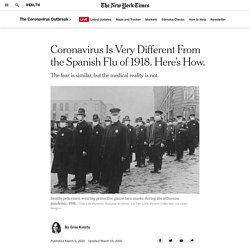
The 1918 flu pandemic, thought to be the deadliest in human history, killed at least 50 million people worldwide (the equivalent of 200 million today), with half a million of those in the United States. It spread to every part of the world, affecting populations in Japan, Argentina, Germany and dozens of other countries. Maybe most alarmingly, a majority of those killed by the disease were in the prime of life — often in their 20s, 30s and 40s — rather than older people weakened by other medical conditions. While the fearful atmosphere — surgical masks, stockpiling of food and avoidance of public gatherings — and potential economic ramifications are like those of 1918, the medical reality is quite different.
“Nurses often walked into scenes resembling those of the plague years of the fourteenth century,” wrote the historian Alfred W. Regardless of the reason, it was a disaster for life expectancy, which plummeted. 1918 Influenza: the Mother of All Pandemics - Volume 12, Number 1—January 2006. Author affiliations: *Armed Forces Institute of Pathology, Rockville, Maryland, USA; †National Institutes of Health, Bethesda, Maryland, USA "Curiouser and curiouser!
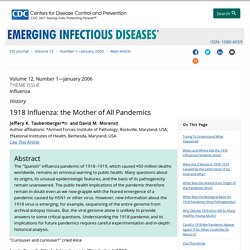
" cried Alice Lewis Carroll, Alice's Adventures in Wonderland, 1865 An estimated one third of the world's population (or ≈500 million persons) were infected and had clinically apparent illnesses (1,2) during the 1918–1919 influenza pandemic. The disease was exceptionally severe. The impact of this pandemic was not limited to 1918–1919. In 1918, the cause of human influenza and its links to avian and swine influenza were unknown. Thus in 2006, 2 major descendant lineages of the 1918 H1N1 virus, as well as 2 additional reassortant lineages, persist naturally: a human epidemic/endemic H1N1 lineage, a porcine enzootic H1N1 lineage (so-called classic swine flu), and the reassorted human H3N2 virus lineage, which like the human H1N1 virus, has led to a porcine H3N2 lineage. Trying To Understand What Happened Figure 1 Figure 1. Situation Summary. CDC Recommends Everyone can do their part to help us respond to this emerging public health threat by following CDC recommendations: Wear a cloth face covering in public settings to avoid spreading COVID-19 to others in case you are infected but do not have symptoms.The cloth face cover is meant to protect other people in case you are infected.The cloth face coverings recommended are not surgical masks or N-95 respirators.
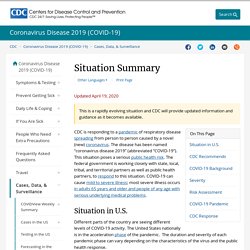
Those are considered critical supplies that should be reserved for healthcare workers and other first responders, as recommended by CDC.The cloth face covering is not a substitute for social distancing.CDC continues to recommend that people try keep about 6 feet between themselves and others. The White House “Slow the Spread” guidelinespdf iconexternal icon are in place until April 30.
These are part of a nationwide effort to slow the spread of COVID-19 through the use of social distancing at all levels of society. People who are sick Travelers. The Epidemiological Characteristics of an Outbreak of 2019 Novel Coronavirus Diseases (COVID-19) — China, 2020. Background: An outbreak of 2019 novel coronavirus diseases (COVID-19) in Wuhan, Hubei Province, China has spread quickly nationwide.
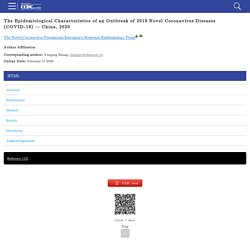
Here, we report results of a descriptive, exploratory analysis of all cases diagnosed as of February 11, 2020. Methods: All COVID-19 cases reported through February 11, 2020 were extracted from China’s Infectious Disease Information System. Analyses included the following: 1) summary of patient characteristics; 2) examination of age distributions and sex ratios; 3) calculation of case fatality and mortality rates; 4) geo-temporal analysis of viral spread; 5) epidemiological curve construction; and 6) subgroup analysis.
Results: A total of 72,314 patient records—44,672 (61.8%) confirmed cases, 16,186 (22.4%) suspected cases, 10,567 (14.6%) clinically diagnosed cases (Hubei Province only), and 889 asymptomatic cases (1.2%)—contributed data for the analysis. FIGURE 4. DEFINE_ME. The WHO Scientific and Technical Advisory Group for Infectious Hazards (STAG-IH), working with the WHO secretariat, reviewed available information about the outbreaks of 2019 novel coronavirus disease (COVID-19) on Feb 7, 2020, in Geneva, Switzerland, and concluded that the continuing strategy of containment for elimination should continue, and that the coming 2–3 weeks through to the end of February, 2020, will be crucial to monitor the situation of community transmission to update WHO public health recommendations if required.
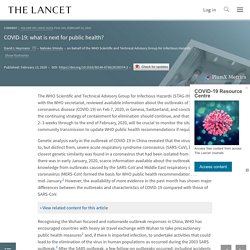
Genetic analysis early in the outbreak of COVID-19 in China revealed that the virus was similar to, but distinct from, severe acute respiratory syndrome coronavirus (SARS-CoV), but the closest genetic similarity was found in a coronavirus that had been isolated from bats. Lu R Zhao X Li J et al. Genomic characterisation and epidemiology of 2019 novel coronavirus: implications for virus origins and receptor binding. Lancet. 2020; () Disease outbreak news. Lee SH. Commentary: Challenges to Achieve Conceptual Clarity in the Definition of P...: EBSCOhost. Globalization's Contradictions : Geographies of Discipline, Destruction and...: EBSCOhost.
IMPACT OF GLOBALIZATION ON HIV/AIDS PANDEMICS AND THE CHALLENGES OF COMPULS...: EBSCOhost. Pandemics, Pills, and Politics : Governing Global Health Security: EBSCOhost. Disaster Education. [electronic resource] : ‘Race’, Equity and Pedagogy: EBSCOhost. Understanding the socioeconomic heterogeneity in healthcare in US counties:...: EBSCOhost. What Explains Cross-City Variation in Mortality during the 1918 Influenza P...: EBSCOhost. The use of gamification in the teaching of disease epidemics and pandemics: EBSCOhost. Physician's knowledge, attitudes, and practices regarding seasonal influenz...: EBSCOhost. Global Lessons from the AIDS Pandemic. [electronic resource] : Economic, Fi...: EBSCOhost.
Pandemics: what everyone needs to know: EBSCOhost. Mass mediated disease : a case study analysis of three flu pandemics and pu...: EBSCOhost. Public Health Control Measures in Response to Global Pandemics and Drug Res...: EBSCOhost. Understanding the socioeconomic heterogeneity in healthcare in US counties:...: EBSCOhost. Knowledge, risk perceptions, and preventive precautions among Hong Kong stu...: EBSCOhost. Pandemic Influenza and Community Preparedness: EBSCOhost. Pandemic influenza preparedness : hearing before a subcommittee of the Comm...: EBSCOhost. Hand hygiene and infection control survey pre- and peri-H1N1-2009 pandemic:...: EBSCOhost. Survey of Healthcare Workers' Attitudes, Beliefs and Willingness to Receive...: EBSCOhost. Capacity to care in a world living with AIDS : hearing before the Committee...: EBSCOhost.
Pollution, Infectious Disease, and Mortality: Evidence from the 1918 Spanis...: EBSCOhost. The Challenges of 'Continuing Medical Education' in a Pandemic Era: EBSCOhost. Predictive factors associated with the acceptance of pandemic and seasonal ...: EBSCOhost. Impact of pandemic flu training on ability of medical personnel to recogniz...: EBSCOhost.